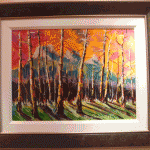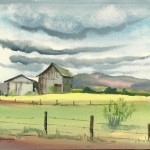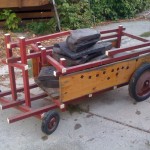The possibilities for unending creative invention paired with skilled craftsmanship and happenstance intrigue me. I find them seductively lurking in the creation of paste papers and itajime (fold and clamp tie dye) papers. So much so, that I have been studying and working with paste papers since 1990 and with shibori (Japanese tie dye) since 1977.
I have elected to work with processes that allow partnership between creative intuition, effective design, process, technique, color and material. I usually work in collage, by putting pieces together, because this process permits me to assess the relationships between the parts during the development of an artwork and allows for changes in the work along the way.
Shibori is an umbrella term for the hundreds of variations of Japanese tie-dye. It literally means “manipulated resist dyeing.” In resist dyeing, one does something to material such as fabric, paper, or leather to keep a colorant away. Wax resist dyeing (batik) is an example of applied resist dyeing. Shibori is different from batik in that the material is manipulated in some fashion – folded, scrunched, stitched, tied, clamped, etc, – and held in place so that the colourant (usually dye) can not penetrate the material. Shibori can be a highly controlled technique. One of the most wonderful aspects of this process is that even with a pre-eminent amount of experience, skill and control the natural physical process influences the outcome. It is like a dance between the artist and the process. The artist can plan and anticipate most of what will develop and can know all of the moves, but there is always a little synergy, a surprise or gift from the process and materials themselves that enhances the tango and is a surprise. One can know all of the steps, but in a partnership there is an element of the unknown, the unexpected happens.
I have been intrigued by and have worked with shibori processes since the late 1970s. My earlier shibori work was done using fabric. Now the majority of my work is done with paper.
Itajime—Japanese, (eee-tah-ji-may) ‘fold and clamp’ shibori techniques
Traditionally, itajime dyed papers were created as winter work for Japanese farmers, when they could not be in the fields working. The papers are usually first folded in a concertina fan and then folded in the opposite direction in either rectangles or triangles; the folding, like origami folding, needs to be precise. The stacks of paper are then clamped and dipped into colourants. The patterning that develops from the dip-dyeing can be highly controlled and regularized, and always has small unique variations in every pattern unit. These variations are the prized characteristics of itajime dyed paper. Variations are caused by the characteristics of the paper, the temperature and humidity, the type of colorant used, and by the manner in which the color is applied. The best paper to use is thin, has very high wet strength and is absorbent and has no starch or sizing. Of course other papers can be used with different results. The process is delicate and the paper tears easily and too much colourant can ruin the outcome.
For me, as an artist and avid flower gardener, the variations in itajime dyed paper patterns that I create are homage to nature. The small variations in itajime emulate nature. All flowers of a particular species are the same, but when one carefully observes each one there are little variations in each one. Sunrise or sunsets are all the same, the sun comes up or goes down; when one pays close attention each one is different from all of the others.
Katano shibori This specialized technique in named after a Japanese artist, Mr. Katano, who invented this variation of shibori techniques using hand stitching in patterns to hold a fan folded fabric in place. In my variation of this shibori process, paper is folded and a sheath is placed on each side of the stack; then the ‘sandwich’ is stitched through using a sewing machine. This is immersed in dye for several days, and frequently manipulated to encourage dye to penetrate the delicate folds of paper. After dyeing, the extremely fragile paper is rinsed to remove excess dye.
The end results of successful papers are worth the effort, The paper I choose to use is fragile and resistant to dye absorption, there can be a high failure rate with this process! Katano shibori, like itajime, requires a great deal of skill and control while also offering many wonderful, unexpected results! The Katano process yields a result that cannot be achieved in any other manner.
Sewing on Paper I learned to sew on paper provided by my father. When I was six or seven he taught himself how to use a sewing machine in order to reupholster furniture for our family to use. I must have been hanging on his every move, because he bought me a little hand crank sewing machine of my own. He gave me a paper with mazes drawn on it and said that when I could follow the lines with needle holes, he would give me thread to use. Decades later, in the midst of teaching at university, creating art quilts, making paper and shibori dyed fabrics, I started to collage bits of hand made paper together. Sewing seemed like a natural means of joining the papers together. I also learned to draw using a sewing machine to create line. Since then, sewing papers has been my favorite means of creating collage. The physicality of the end product is appealing to me; I like the bas-relief result. Many artwork images are illusions. The collages I create may be illusions, but they are also real objects in and of themselves.
Paste Painted Papers were first created in 16th Century Europe by book binders who needed special papers for their work. Today these historic paste-papers are the great ancestors of what we know of as children’s finger painting. I started creating paste papers for use in my own collages and soon became intrigued with ‘finger painting’ and can be just as much fun for an adult as for a child! There are an unending number of possible techniques and variations. These techniques enable an artist to create precisely what is needed for specific artworks in terms of color, texture and pattern. The process is like ones’ signature; it is easy to identify one professional paste-painters work from another’s. The process encourages invention because each different tool creates a variation, and using each tool in a unique manner creates a different variation. A paste-painter is always on the lookout for new hardware, kitchen and garage sale treasures to use in the next new design. I create paste papers for my own aesthetic needs as well wholesaling them to artists, art supply stores and specialty paper shops.





